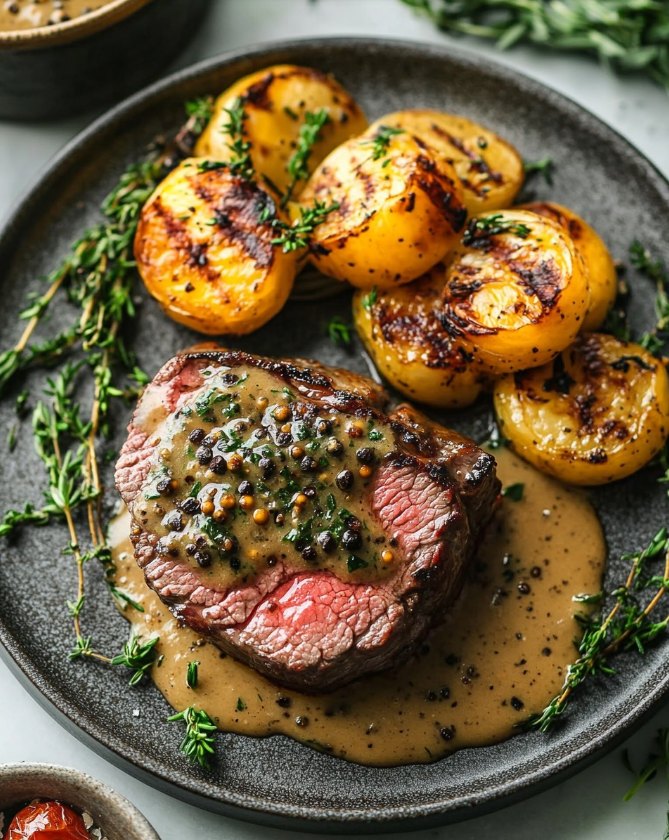Why This Reverse Seared Filet Mignon Recipe Will Wow Your Taste Buds
There’s something magical about a perfectly cooked filet mignon. The first time I made this reverse seared filet mignon with creamy peppercorn brandy sauce, it was for my husband’s birthday. I wanted to impress him without spending hours in the kitchen. The result? A tender, juicy steak with a buttery crust that melted in our mouths, paired with a rich, velvety sauce. It felt like dining at a fancy restaurant—except we were in sweatpants. This recipe is special because it combines simplicity with gourmet flavors, making it perfect for date nights or dinner parties.
The Story Behind Reverse Seared Filet Mignon
The reverse sear method might sound fancy, but it’s actually one of the easiest ways to cook steak. Traditionally, steaks are seared first and then finished in the oven. The reverse sear flips that process by slow-cooking the steak in a low-temperature oven before giving it a quick sear. This technique ensures even cooking and a beautifully caramelized exterior. While filet mignon itself is a classic French cut, the peppercorn sauce adds an extra layer of indulgence, inspired by bistros across Europe. Whether you’re new to cooking steak or a seasoned pro, this dish will elevate your culinary game.
Why You’ll Love This Recipe
What’s not to love? First, the reverse sear method guarantees a perfectly pink center every time. No more guesswork or overcooked edges. Second, the peppercorn sauce is the ultimate finishing touch. With its creamy texture, bold flavors of brandy, Dijon mustard, and cracked black pepper, it’s like a warm hug for your taste buds. Plus, the entire dish comes together in under an hour, making it ideal for busy weeknights or last-minute gatherings.
Perfect Occasions to Prepare This Dish
This reverse seared filet mignon is perfect for romantic dinners, anniversaries, or holiday feasts. I’ve also served it during casual get-togethers with friends, and everyone raved about how “restaurant-quality” it tasted. If you’re looking to impress someone—or just treat yourself—it’s the ultimate showstopper.
Ingredients You’ll Need
Here’s what you’ll need to create this mouthwatering dish:
- For the Filet Mignon:
- 4 steaks of filet mignon (170-225g each)
- Sel kasher and freshly ground black pepper, to taste
- 1 tbsp neutral oil (like avocado or canola)
- 1 tbsp unsalted butter
- For the Sauce:
- 1/4 cup finely chopped shallots
- 2 tsp minced garlic
- 1 tbsp all-purpose flour
- 1/4 cup brandy
- 3/4 cup low-sodium beef broth
- 1/2 cup heavy cream
- 1 tbsp Dijon mustard
- 2 tsp coarsely ground black peppercorns
Substitution Options
If you’re missing an ingredient, don’t panic! Here are some swaps:
- Can’t find filet mignon? Use ribeye or sirloin instead.
- No brandy? Substitute with cognac or even red wine.
- Out of heavy cream? Try half-and-half or coconut cream for a dairy-free option.
- Dijon mustard unavailable? Whole grain mustard works too!
Step-by-Step Preparation
Step 1: Dry Brine the Steaks
Start by seasoning your steaks generously with kosher salt. Place them on a baking sheet lined with parchment paper and let them sit uncovered for an hour (or overnight in the fridge). This step, called dry brining, helps draw out moisture from the surface, creating a crispier crust later. Pro tip: Let the steaks come to room temperature 30 minutes before cooking for even results.
Step 2: Slow-Cook the Steaks
Preheat your oven to 225°F (107°C). Pat the steaks dry with paper towels and season them with freshly ground black pepper. Place them directly on the baking sheet and pop them into the oven. Cook until their internal temperature reaches 110-115°F (43-46°C) for medium-rare, which usually takes 25-28 minutes. Using a meat thermometer ensures precision—no more guessing games!
Step 3: Sear the Steaks
Heat a cast-iron skillet over medium-high heat. Add oil and butter, swirling the pan until the butter melts and turns golden. Carefully place the steaks in the pan and sear for 2 minutes per side, flipping every 30 seconds. This technique creates a gorgeous caramelized crust while locking in juices. Transfer the steaks to a plate and let them rest for 5-8 minutes.
Step 4: Make the Sauce
In the same skillet, sauté shallots until soft and translucent, then toss in garlic for 30 seconds. Sprinkle in flour to thicken the base, followed by brandy to deglaze the pan. Scrape up those flavorful brown bits—they’re pure gold! Pour in beef broth, heavy cream, Dijon mustard, and peppercorns. Simmer until the sauce thickens slightly, then adjust seasoning to taste.
Chef’s Tip
“Don’t skip resting the steaks after cooking. It allows the juices to redistribute, keeping the meat incredibly tender.”
Timing Breakdown
- Prep Time: 15 minutes
- Cooking Time: 35 minutes
- Resting Time: 10 minutes
- Total Time: 50 minutes
Chef’s Secret
To take your reverse seared filet mignon to the next level, brush the steaks with herbed butter right after searing. Simply mix softened butter with chopped parsley, thyme, and a pinch of garlic powder. Trust me, it’s worth the effort!
Extra Info
Did you know that filet mignon comes from the smaller end of the tenderloin muscle? Because this area gets minimal exercise, it’s naturally tender and lean, making it ideal for quick, high-heat cooking methods like reverse searing.
Necessary Equipment
To make this dish, you’ll need:
- A baking sheet and parchment paper
- A cast-iron skillet
- A meat thermometer
Storage Tips
Leftovers? Lucky you! Store the steaks and sauce separately in airtight containers in the fridge for up to 3 days. Reheat gently in a skillet to retain moisture. For longer storage, freeze the steaks wrapped tightly in plastic wrap and foil for up to 3 months.
If reheating frozen steaks, thaw them overnight in the fridge and warm them in the oven at 275°F (135°C) until heated through. Avoid microwaving, as it can dry out the meat.
Tips and Advice
- Use a sharp knife to slice the steaks thinly against the grain for maximum tenderness.
- Double-check the internal temperature with a reliable thermometer.
- Don’t overcrowd the skillet when searing; work in batches if needed.
Presentation Ideas
Elevate your plating game by garnishing the steaks with fresh herbs like parsley or chives. Serve alongside roasted vegetables, mashed potatoes, or a simple arugula salad tossed with lemon vinaigrette. Drizzle the peppercorn sauce artfully around the plate for a professional touch.
Healthier Alternatives
Looking for lighter options? Try these variations:
- Grilled Filet: Swap the oven for a grill to reduce added fats.
- Balsamic Glaze: Replace the peppercorn sauce with a tangy balsamic reduction.
- Herb Marinade: Marinate the steaks in olive oil, rosemary, and thyme for added flavor.
- Veggie Pairings: Serve with grilled zucchini or asparagus instead of creamy sides.
- Lemon Butter Sauce: Skip the cream and whisk in lemon juice and butter for brightness.
- Portobello Option: Grill portobello mushrooms using the same method for a vegetarian twist.
Common Mistakes to Avoid
Mistake 1: Skipping the Thermometer
Guessing the doneness of your steak often leads to disappointment. Invest in a good-quality meat thermometer to ensure accuracy. Aim for 110-115°F (43-46°C) for medium-rare during the reverse sear stage.
Mistake 2: Overcrowding the Pan
Cooking multiple steaks in one pan causes them to steam rather than sear. Work in batches to achieve that coveted golden crust.
Mistake 3: Rushing Rest Time
Resting allows juices to settle back into the meat. Cutting into the steak too soon lets those precious juices escape, leaving you with a drier result.
FAQ
What does reverse seared mean?
Reverse searing means cooking the steak slowly in the oven first, then finishing it with a quick sear in a hot pan. This method ensures even cooking and a crispy exterior.
Can I use a different cut of meat?
Absolutely! Ribeye or sirloin are great alternatives if filet mignon isn’t available.
How do I store leftovers?
Store leftover steaks and sauce separately in airtight containers in the fridge for up to 3 days. Reheat gently in a skillet or oven.
Is reverse searing better than regular searing?
Yes, especially for thicker cuts. It prevents overcooking the edges while ensuring a perfectly cooked center.
Can I make the sauce ahead of time?
Definitely! Prepare the sauce up to a day in advance and reheat it gently before serving.
What’s the best way to reheat filet mignon?
Reheat in a low oven (around 275°F/135°C) until warmed through. Avoid microwaving to prevent drying out.
Do I have to use brandy?
Nope! Red wine or cognac works just as well.
What sides pair well with this dish?
Roasted veggies, mashed potatoes, or a light salad complement the richness of the steak and sauce beautifully.
Can I freeze cooked filet mignon?
Yes! Wrap the steaks tightly in plastic wrap and foil, then freeze for up to 3 months.
How do I know when the steak is done?
Use a meat thermometer. For medium-rare, aim for an internal temperature of 110-115°F (43-46°C) during the reverse sear phase.
Final Thoughts
This reverse seared filet mignon with peppercorn sauce is a game-changer for home cooks. It’s elegant yet approachable, packed with flavor, and surprisingly easy to prepare. Whether you’re celebrating a special occasion or simply treating yourself, this dish promises to deliver big-time satisfaction. So grab your ingredients, fire up the oven, and get ready to wow your loved ones with a meal they won’t forget!

Reverse Seared Filet
Ingredients
Equipment
Method
- Season the steaks with kosher salt and let them sit uncovered for an hour (or overnight in the fridge).
- Preheat your oven to 225°F (107°C) and pat the steaks dry before seasoning with freshly ground black pepper.
- Place the steaks on a baking sheet and cook until their internal temperature reaches 110-115°F (43-46°C) for medium-rare, which should take 25-28 minutes.
- Heat a cast-iron skillet over medium-high heat, add oil and butter, and once melted, sear the steaks for 2 minutes per side, flipping every 30 seconds.
- Transfer the steaks to a plate and let them rest for 5-8 minutes.
- In the same skillet, sauté shallots until soft, then add garlic for 30 seconds.
- Sprinkle in flour, followed by brandy to deglaze the pan, scraping up the brown bits.
- Pour in beef broth, heavy cream, Dijon mustard, and peppercorns, then simmer until the sauce thickens slightly.
